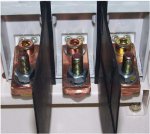Big discount schedules go to people who move product; it's not arbitrary. Maybe they don't buy bulk on every PO, but these sorts of buyers regularly send POs over and at the end of the year, they've bought a ton of product. You can bet money that if you get a good multiplier on something, and then one year you migrate to something else, you'll lose your multiplier. Might take a bit, but your distributor will catch on eventually.
But of course that's not the only thing that goes in to it. If you buy a thousand breakers a year, your distributor will probably cut you a deal on conduit too even if you only buy 50 ft a year. May not be much, but it'll be better than street price. They have an interest in keeping you as a customer. If you start looking elsewhere, who knows what deals you can find, and suddenly your old distributor doesn't get POs anymore.
Also, it depends on your market. My last company got a crazy discount on proximity sensors because they were headquartered in the Detroit area, so there's a TON of volume moving through that area for all the auto plants and machine builders, which means there's a TON of competition for that business. My local rep down here said he'd never seen a discount that steep in this area.


